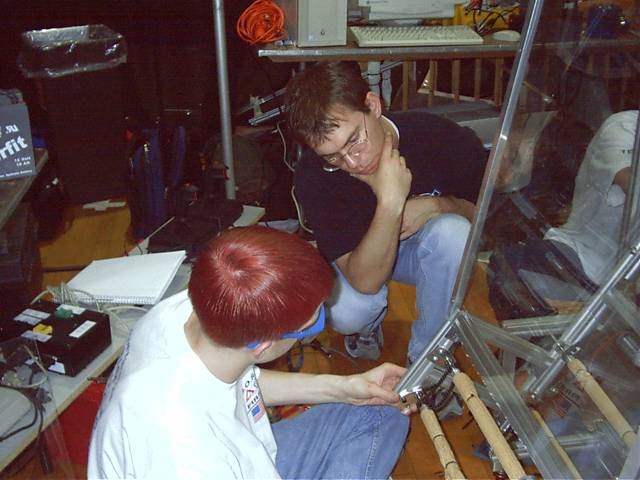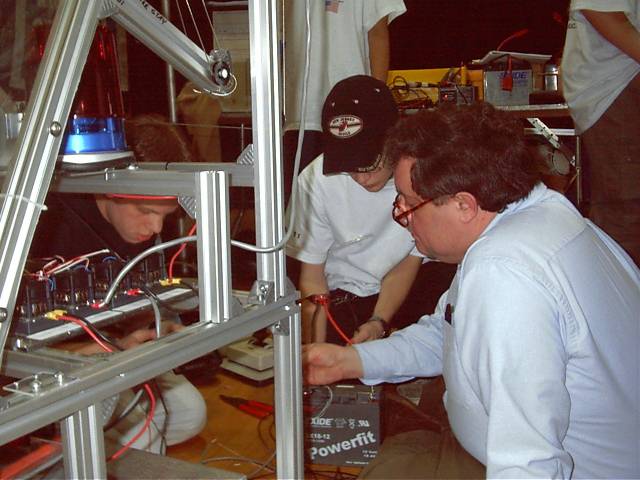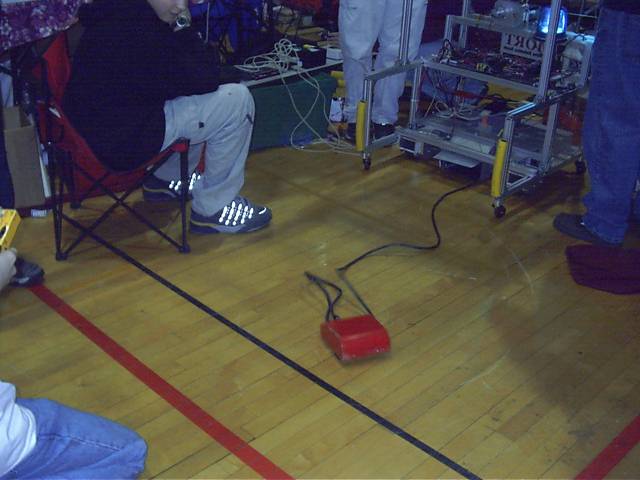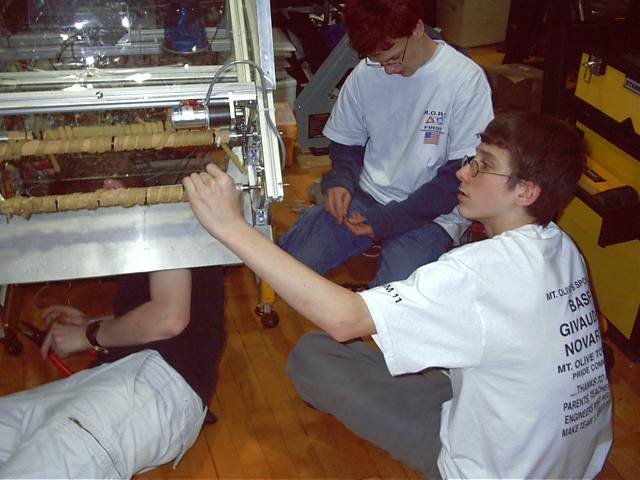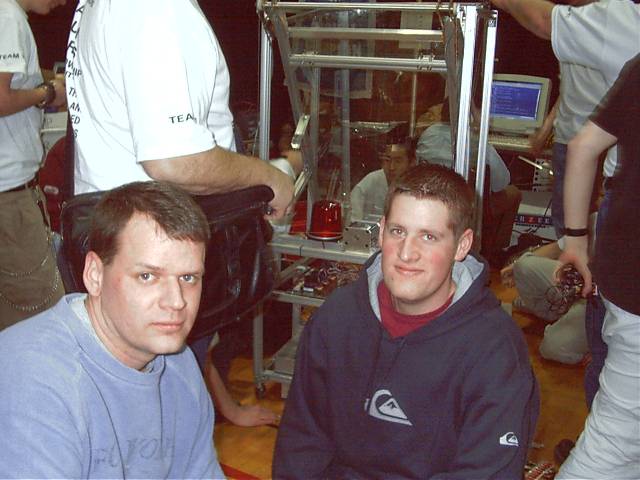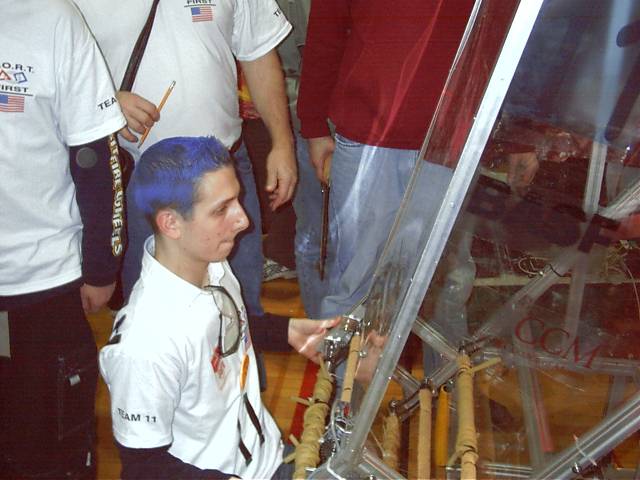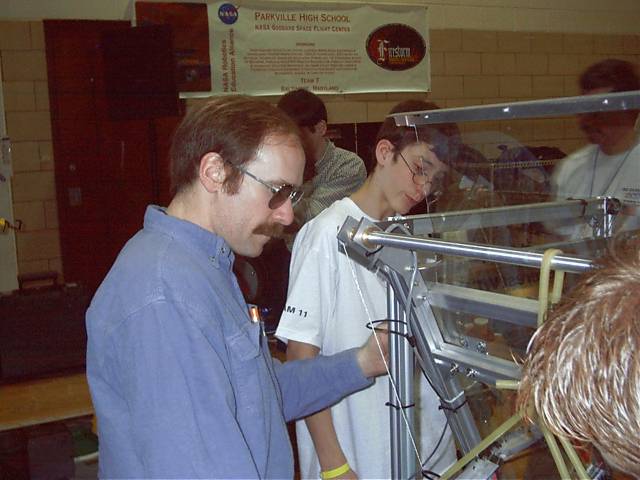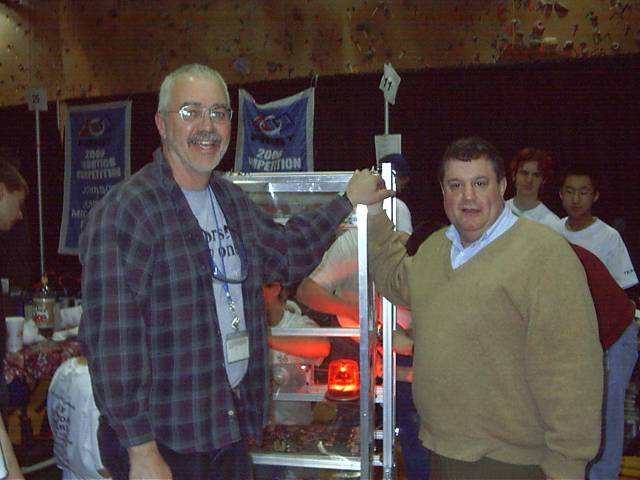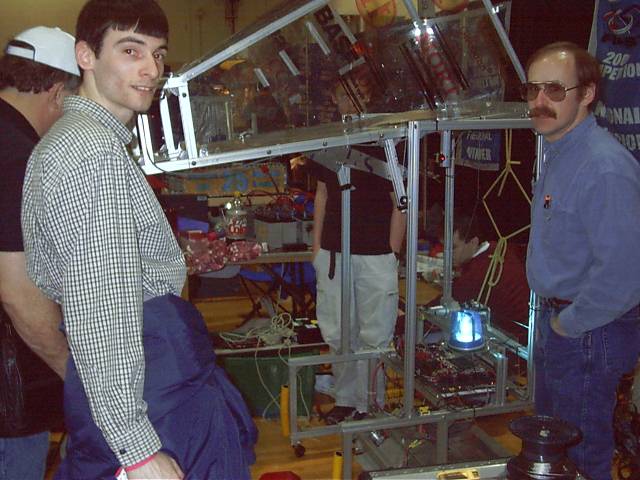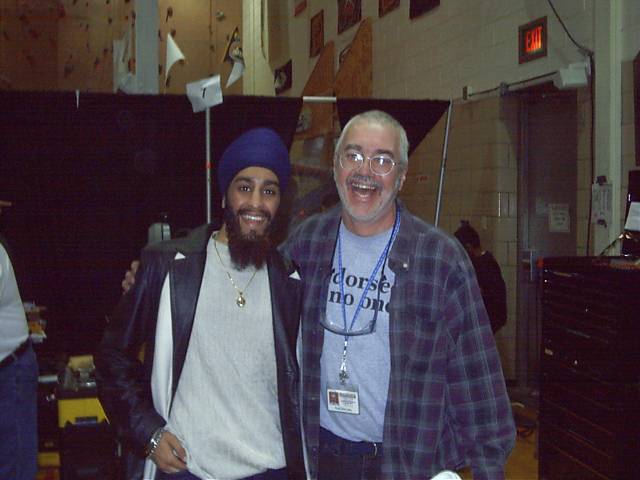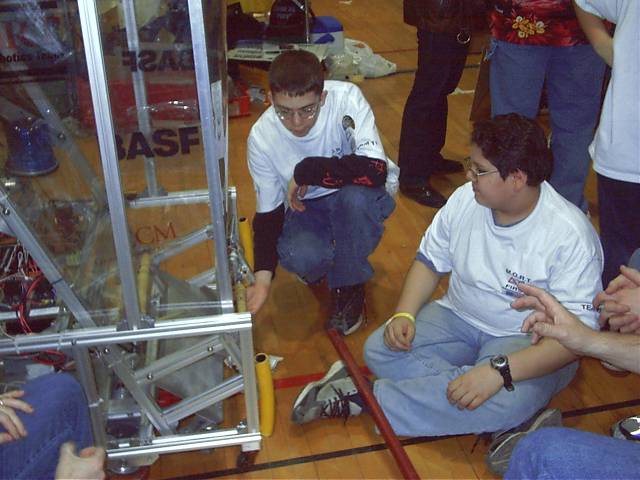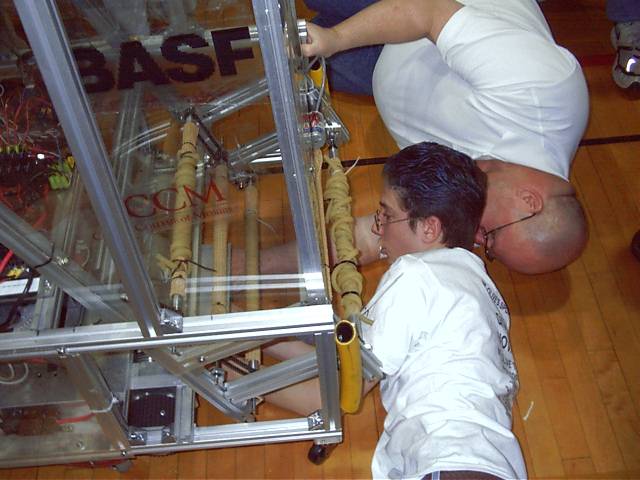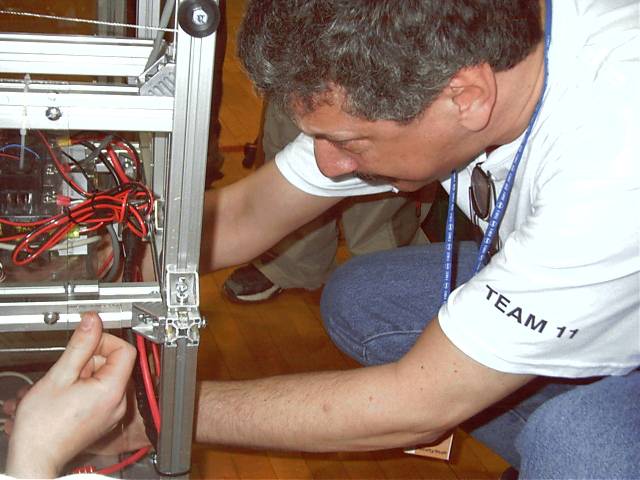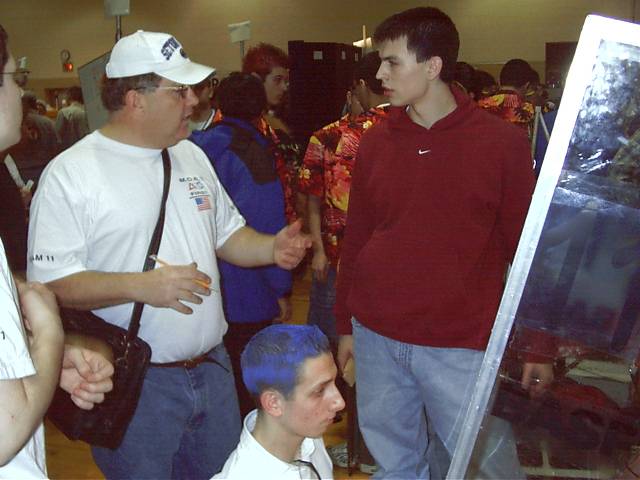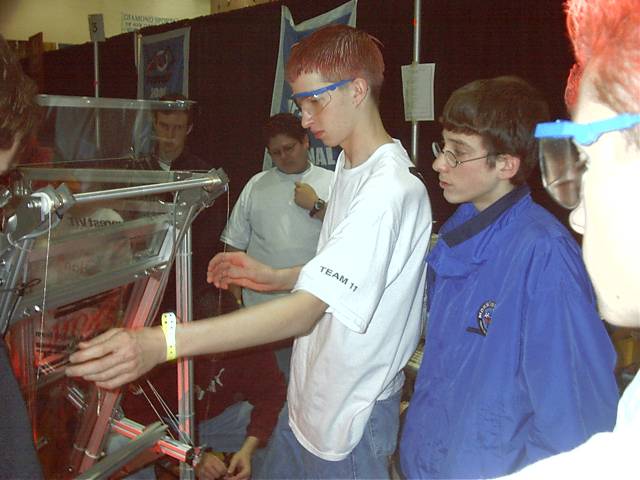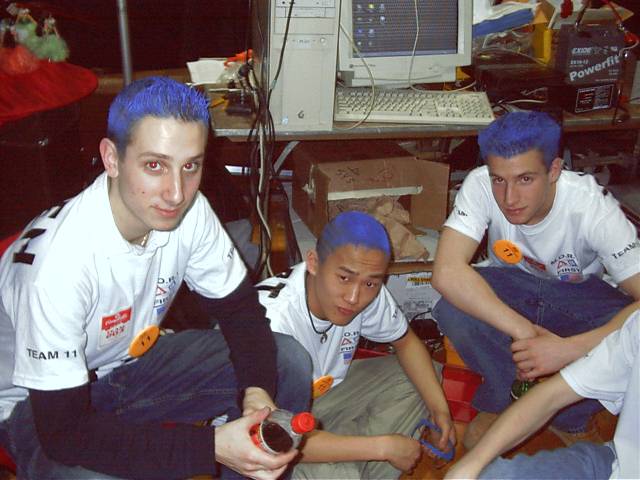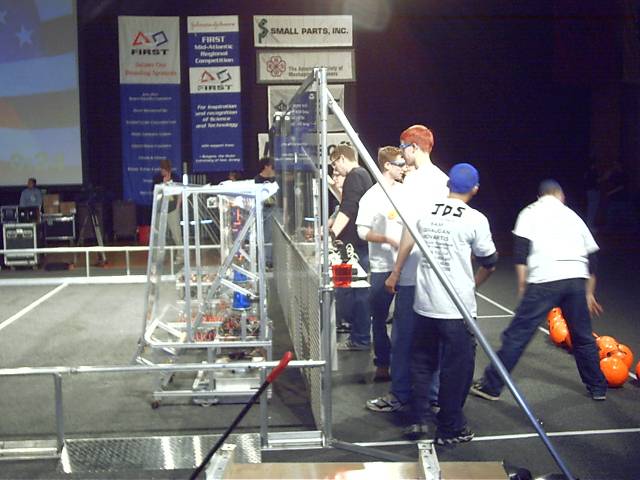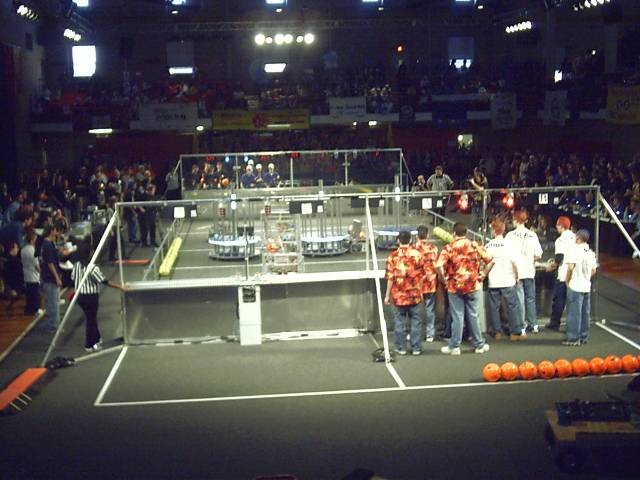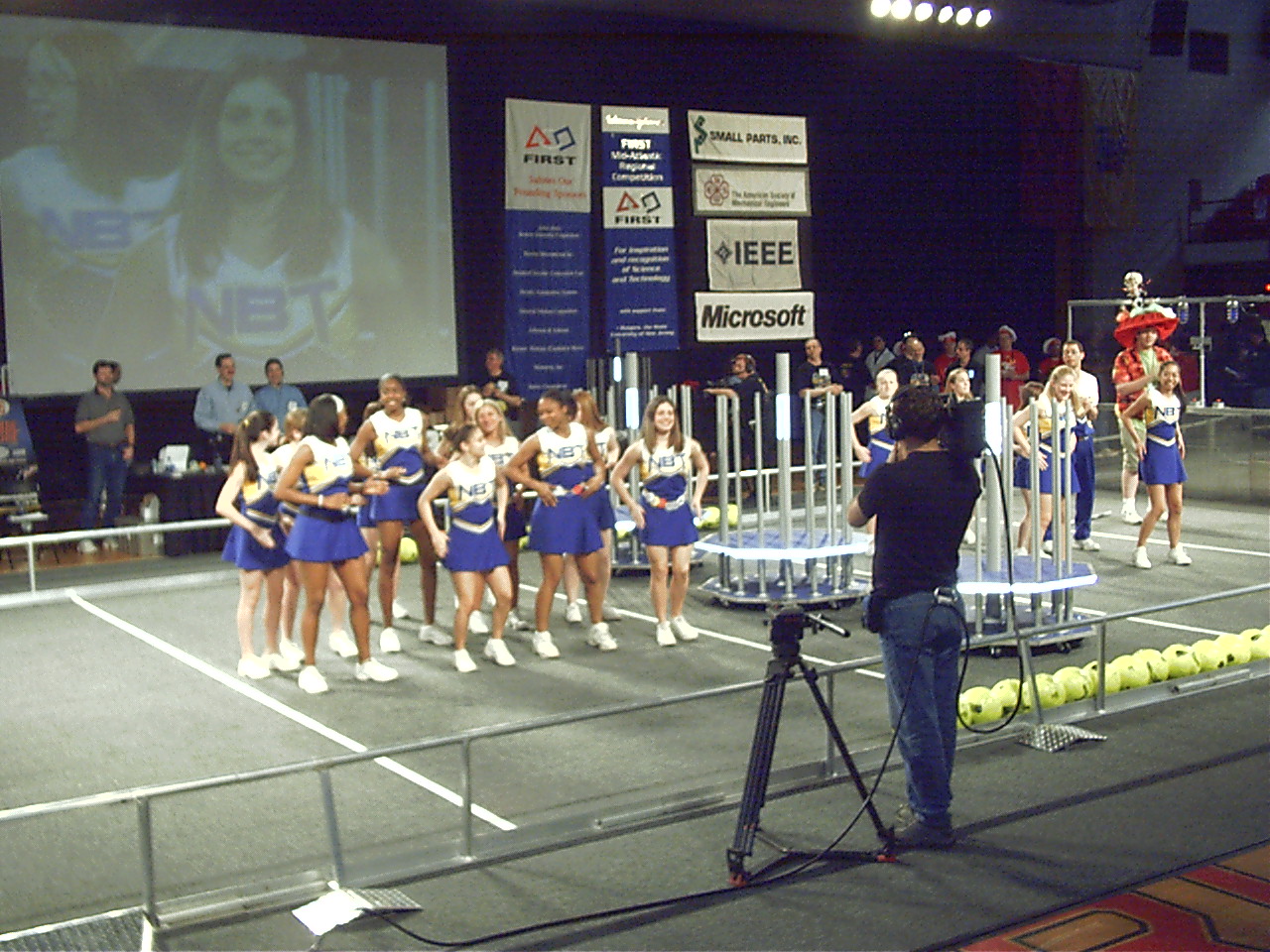
Mt. Olive High/County College of Morris
FIRST Robotics Team-2002
*****************************************************************************
***************************************************************************** *****************************************************************************Once again, the Morris-area FIRST
Robotics team supported by CCM’s Engineering department has pulled off an
unlikely success! After a dismal start, we ended up in second place
overall in the FIRST J&J MidAtlantic Regional Robotics Competition.
The Mount Olive High School-based team
began the Thursday practice sessions with a plethora of mechanical and
electronic problems. By the end of the first day of actual competition (Friday)
the team was seeded in a dismal 30th
place (out of 33 teams!). We assumed that on Saturday, we’d be very
lucky to make it to the top 50%. By the end of the event, our “alliance
team” (us and two other robot team-mates) ended up in second place,
beating dozens of larger and better-funded teams.
How did we make it from “almost last
place” to “almost first place”? A combination of hard work, ingenuity, the
vision of some other teams and good old-fashioned luck.
The team now qualifies to enter the Toronto FIRST Regional Competition in Canada on April 4, 2002! Our team will travel (by bus) with 49 team members (including at least four “CCM people”). Our robot (per FIRST rules) is being shipped in a sealed container (via FedEx) around March 27th directly to Toronto. This means that we’ve had precious little time at Rutgers to do any last minute repairs.

The event began in the Rutgers “old
gym” with a loud, youth-oriented pep rally complete with cheer leaders and a
raucous version of the popular song “YMCA”. Almost every team was out there singing and jumping........
........except us. We were back in the "pit area" desperately trying to
repair an uncooperative “ball scooping” mechanism. Above, volunteer engineer
Jason Ianuzzi (from Everest-VIT
Corp) and Sean Swazck (Mt. Olive student and team driver) consider various
modifications. Some of these changes required complete
re-configuration of the on-board electronics and radio-control system. Here,
Dan, Andy Klages and his father (and CCM faculty member) John Klages, re-invent
the control system “on the fly”. The robot included a tiny mini robot that
could exit the main robot and perform certain scoring-related tasks. The design
was unique (we were the only team with this idea) but unfortunately it was
unreliable in operation. Here Andy is under the robot making an
attempt to repair the “mini-robot garage” while Mario checks the ball roller
“scooping mechanism”. Volunteer engineer Dave Mooney (from
Everest-VIT Corp),Dan and Mario make adjustments to the winch mechanism. The winch
used a series of steel cables to lift the robot’s ball container. When the
ball container was lifted high enough, it would tip balls into a scoring goal.
The cables on this winch gave us continuous problems throughout the event (they
would fray and break or fall off their guides). CCM engineering students Dave Plum and
Larry Briggs provided some important “emergency support”. On Thursday
morning it was discovered that some of the robot’s cable pulleys were completely
unusable. Larry and Dave made a quick visit to the temporary on-site machine
shop that Rutgers had set up. Using some borrowed material and an unfamiliar
lathe, they fashioned a new set of pulleys just in time for practice. We're glad
they're coming to Toronto with us! Mike M. lifts the ball carrier so that
the troublesome cables can be realigned. Parent/volunteer Mike Marvin looks on as
the ball carrier is cycled through it’s lift sequence. Mike is a skilled
electronics technician who taught a number of evening electronics seminars to
the team members in preparation for the competition. CCM faculty members Nial McCabe and John
Klages mugging for the camera while everybody else works! John provided a series
of night seminars in programming for the student "computer team"
during Fall '01. Nial taught a manufacturing/design class to the
"mechanical team" during the same period. Both plan on attending the
Toronto regional. The ball container is being test-lifted
in this picture. It got stuck in this position about 50% of the time! (we're
still trying to devise a "cure" pre-Toronto). On the left is Alex
Blinder, former CCM electronics student and FIRST team member. Alex spent many
hours helping to develop our ’00 robot. He came to this year’s competition
to cheer and show support.Alex is exploring the possibility of a FIRST Robotics linkage or partnership
to his former high school in the Ukraine. We ran into a lot of old team members who are now students
at Rutgers. Here's Nial McCabe with Goggin, the main robot driver from our '00 team. You can almost read their minds….. ”Do you think this thing will finally
work correctly?” Mario and Dave in close quarters. Four
hands are better than two! (note the “CCM” sticker on the side of the
robot). Dozens of people came to cheer and
support the team. They were LOUD! Much of the fund raising, logistics and
organization for the team comes from this dedicated group of supporters. Parent volunteer and “Team Organizer”
Ernie DeCicco, jumps into the fray. At this point we were due out to the
competition floor in about 30 seconds! Team leader/teacher/slave driver Bill
McGowan with student member (and all-around technical expert) “PK”. The entire event was a succession
of “last-minute” repairs but no one gave up. Every member of the team has
“heart”……..that’s why we did so well. If distinctive hair (on Mike, Dave and Tom)would have gotten us
points, we would have won hands-down! Our robot and team at the beginning of
one of the rounds. A over-all view of the playing field in
the Rutgers “Old Gym” (the building was filled to capacity). Our team is on
the right (white shirts). The FIRST Robotics Competition attempts
to achieve a complex and somewhat egalitarian goal: the contest needs to be
“exciting” but should not have a “winning is everything” flavor. In an
attempt to achieve this, FIRST has an entire series of awards at each regional
contest that are not specific to winning, such as “Best Rookie Team”,
“Best Team Spirit”, “Most Innovative Design”, etc. FIRST has been in existence for about 15
years. During that time, a number of "spin-off" robot contests have
been created such as "Robot Wars" and "Robotica". These
commercialized "spin-off" contests tend to emphasize
"fighting" and "showmanship"...........they have very little
in common with FIRST Robotics and are more like a mechanized version of "WWF"
wrestling. This year’s contest (it changes every
year) also used an interesting scheme to keep the scores close: the winner of
each round gets three times the losers score (so it’s best to win by only one
point and not “slaughter” the other team………in some rounds, a team
would score for the opposite side to improve their own score!) After a day and a half of competition,
the contest had reached the “Finals”, where the best teams would battle for
top honors. Each “Finals” team consisted of two robots, but these teams were
required to pick a third partner from the “non-Finals” group. Teams #25
(from North Brunswick, NJ) and #84 (Waverly/Towanda/Bradford, Pa) were grouped
as a “Final” team. They knew we weren’t a top team but they felt that we
had potential and chose us. It was a good choice; our robot performed perfectly
in the "Finals" and a number of our scoring moves helped our
three-robot “Red” team get to second place overall!
Info on "FIRST Robotics": The concept of FIRST came from Dean Kamen (lately,
more well-known as the creator of the mysterious "Ginger/It" invention). In
Dean's view, modern young people have the wrong kind of "heroes". Some of the
more notorious "millionaire heroes" are terrible role models, and even the
well-behaved ones provide a social value that is limited to "entertainment".
Against this view, Dean notes the enormous social value of people in science
and engineering. He includes the true heroes as those who discovered the cure
for Polio or the inventors of the heart pacemaker. He would view the
development of the automotive air bag as a much more powerful social
contribution than some display of entertainment-oriented skills. Dean sees
many of our social values as "turned upside down", in favor of less important
superficial values.
His efforts with FIRST are to correct the notion that being smart is "uncool"
or for "nerds". An important part of the FIRST concept involves "raising the
bar" in American education by emphasizing science, writing skills, math and
engineering (for more info, go to: www.usfirst.org).
Dozens of U.S. and international companies support FIRST including Baxter,
DaimlerChrysler, Delphi, GM, J&J, Motorola, Xerox, AutoDesk, FedEx and
Microsoft. FIRST has also been cited by two U.S. presidents and the numerous
state departments of education (including New Jersey's).
We’ll have more to report after we
return from our Toronto FIRST Competition (aka, “Robots, eh?”) NOTE: No robots were injured or
mistreated in the course of this competition.
